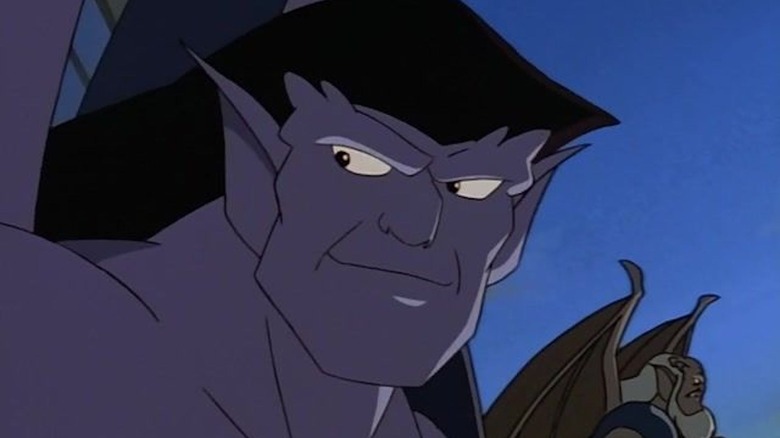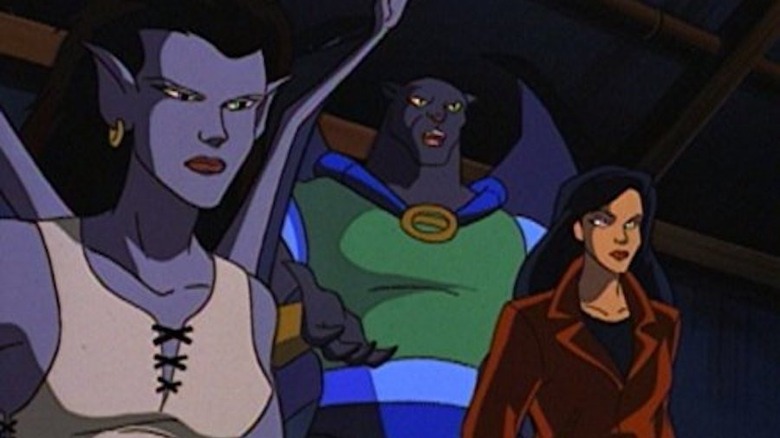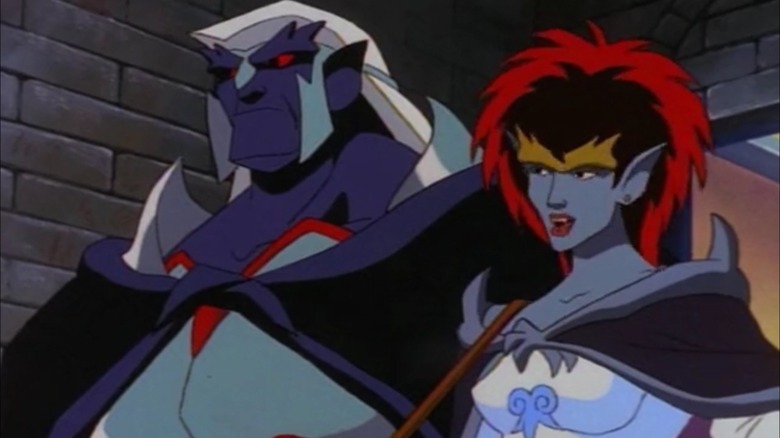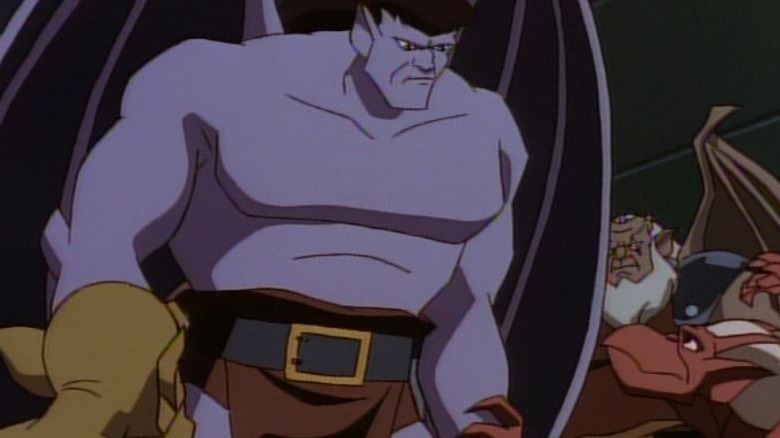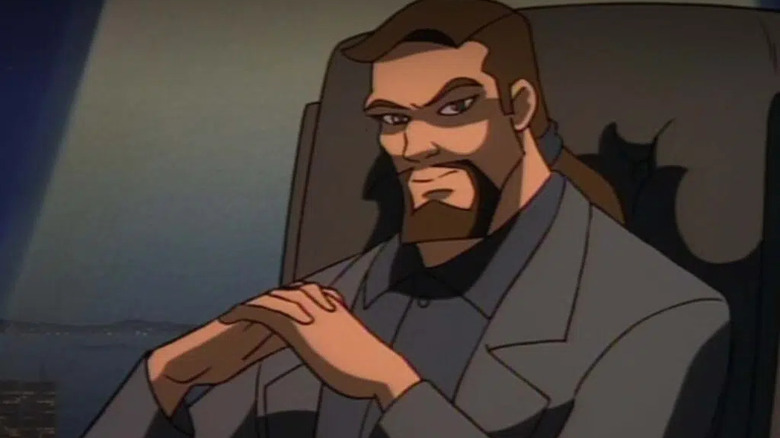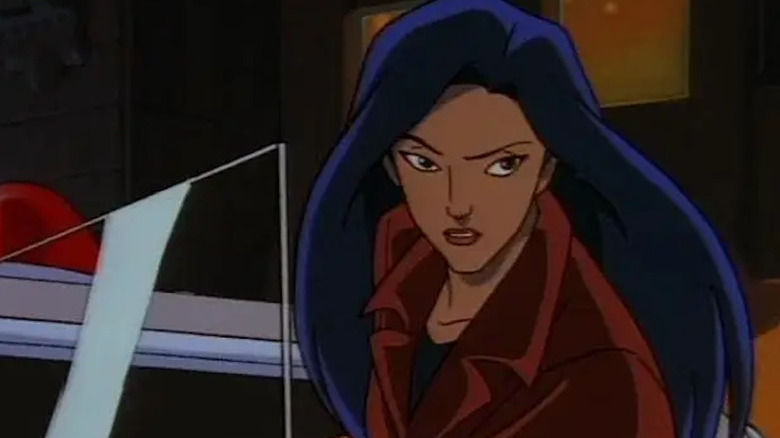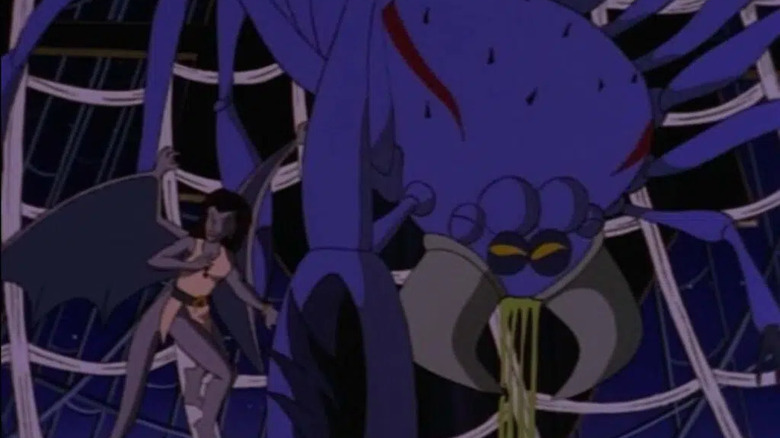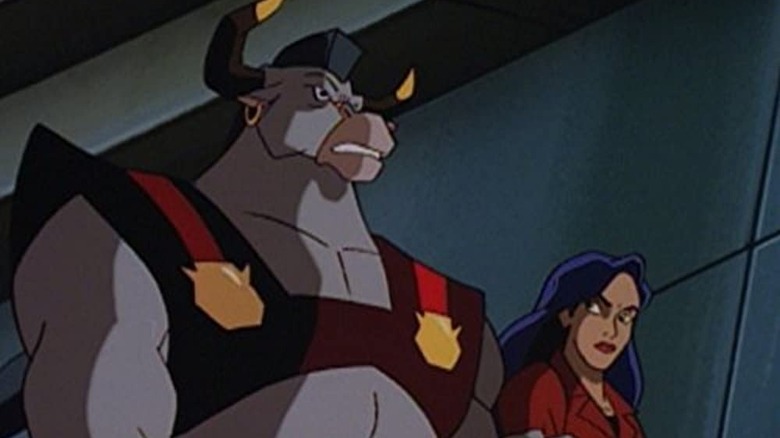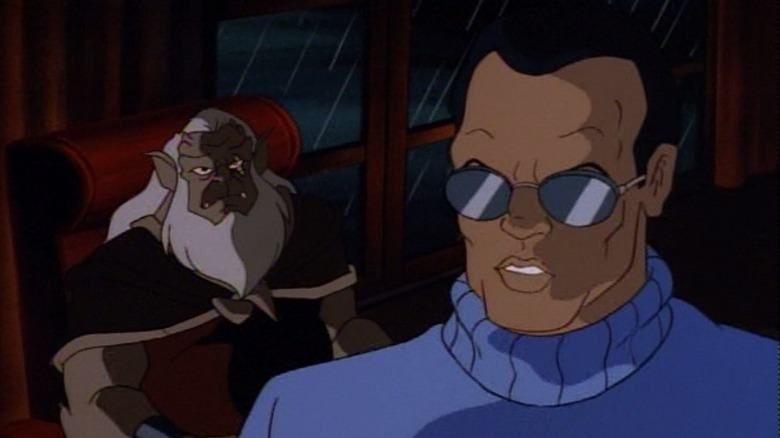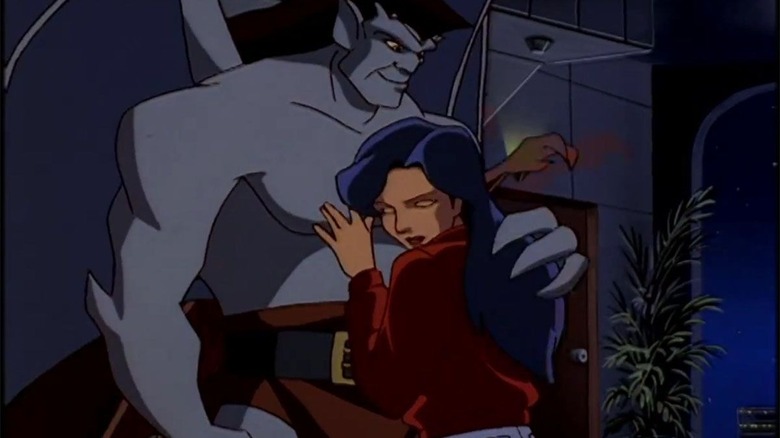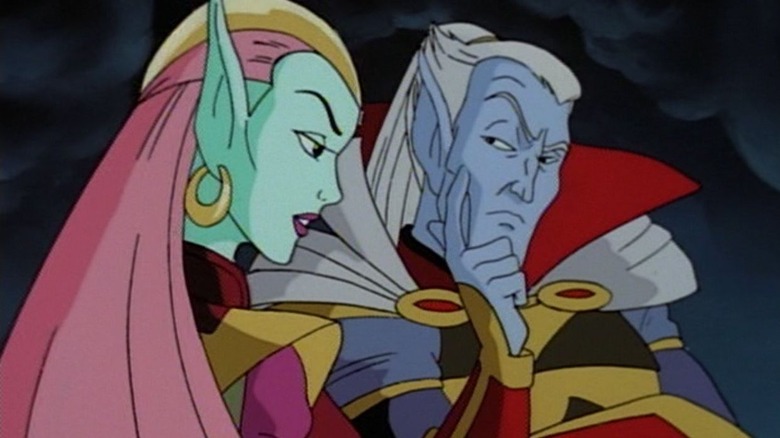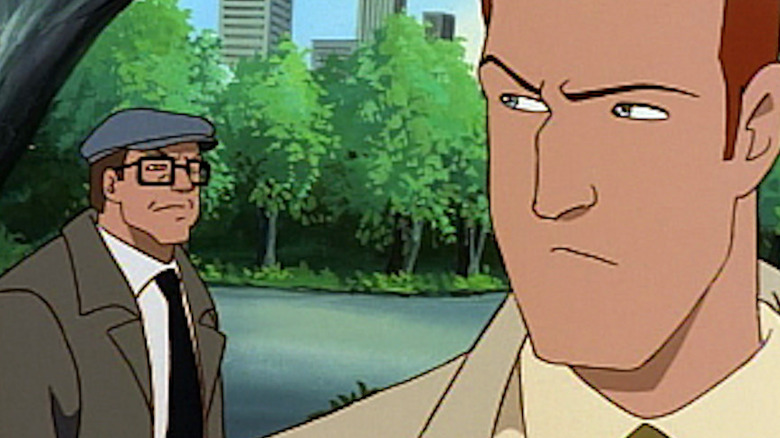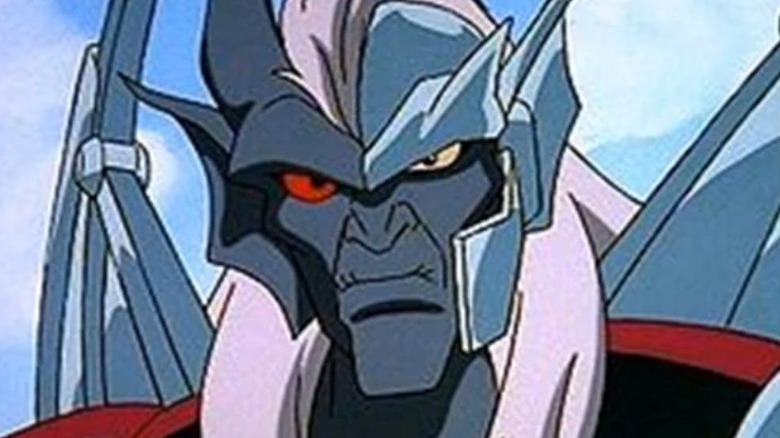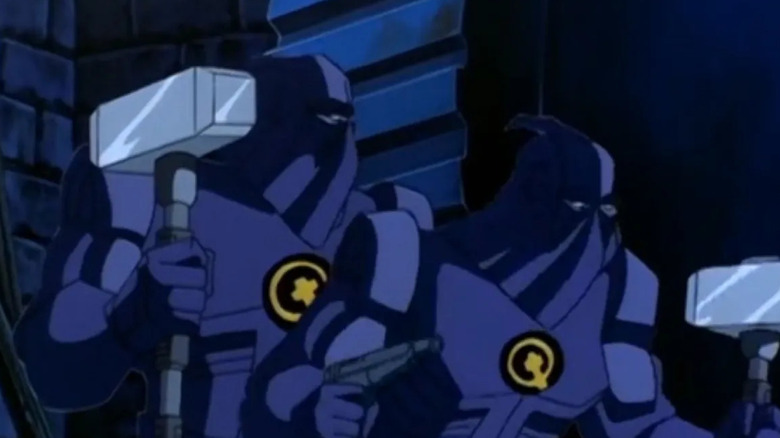Things Only Adults Notice In Gargoyles
Among the most beloved animated series of the '90s, Disney's "Gargoyles" aired on weekday afternoons for two years starting in 1994, before becoming "The Goliath Chronicles" and transitioning to Saturday morning for its final season. Created by writer-producer Greg Weisman, who would go on to mastermind "Spectacular Spider-Man" for Marvel and "Young Justice" for DC, "Gargoyles" includes some of the most complex, engaging, and deeply moving stories you're likely to find in a children's cartoon of its era.
The story begins in 994, where living gargoyles protect a Scottish castle by night. But when one man makes a corrupt deal for control of the castle, the gargoyles are blamed, and a young wizard casts a spell that leaves them frozen in stone for a millennium. After the gargoyles are reawakened in 1994 in New York City, the ruthless business magnate David Xanatos attempts to control them; fortunately, they manage to break free and make a home within a clocktower. Aided by the friendship of Elisa Maza, a young police detective, Goliath — leader of the clan — and his faithful gargoyle family help protect New York.
But "Gargoyles" is far more than a children's superhero adventure series. With mature themes and intricate stories, it dazzles adults as frequently as children. Now available on Disney+, audiences are seeing it all over again. Now that we're all grown up, there are plenty of elements in the series that we're only noticing now.
Serialized, episodic storytelling
Think back to the 1980s and early '90s, and you won't recall too many shows that embrace long-form storytelling the way many shows do today. Plots that move their way through dozens of episodes or more and characters whose stories grow and evolve over the course of shows from that era are fairly rare. Alongside "X-Men: The Animated Series" and a few other like-minded programs, Disney's "Gargoyles" helped normalize animated television that follows characters across series-long journeys.
In "Gargoyles," characters grow and change from episode to episode; their relationships evolve, and they learn lessons that carry them into future stories. The past also influences "Gargoyles" — events that take place as far back as the pilot episode, set a thousand years before, remain relevant well into "Gargoyles" Season 2. According to creator Greg Weisman, his staff of writers worked hard to create a complex web of connected stories, characters, and events that build a rich series-spanning tapestry.
"Some of it was dumb luck. Serendipity. ... [other times] we planned ahead," Weisman said on his website's expansive FAQ. "Personally, I had some long-term plans." Originally, Weisman envisioned "Gargoyles" as one sprawling, serialized saga, as had long been the custom for comic books and daytime soap operas. In the end, that approach to storytelling became key to his show's appeal.
Complicated villains
In most kids' action cartoons, heroes are good, villains are bad, and that's all you need to know. In "Gargoyles" things are not so black and white.
Unlike most shows of its era, "Gargoyles" includes baddies with agendas that are not necessarily as simple or as limited as total destruction or world domination. Xanatos is mostly driven by wealth and power, and only resorts to violence when it's necessary for those specific ends. He even becomes an ally of Goliath and company by the conclusion of the series. Demona — a villainous gargoyle — is determined to wipe out humanity but views herself as a crusader for justice. Derek Maza, who becomes the mutate Talon, has a tragic backstory and mostly turns to crime as a means to regain his humanity.
Some antagonists on "Gargoyles" aren't really villains at all — they're more like victims of unfortunate misunderstandings. For one example, there's Macbeth — an immortal man who initially seeks to use the gargoyles for his own vengeful ends, but eventually reveals himself as a noble warrior whose anguished soul has twisted him into an unscrupulous antihero.
Much like "Batman: The Animated Series," which came along a few years earlier, "Gargoyles" isn't afraid to delve into its villains' backstories to frame them as sympathetic and relatable. The kids in the audience might not realize this sets "Gargoyles" apart from the afterschool animation pack, but adults can certainly pick up on it.
Gargoyles is about parenting
At the core of "Gargoyles," there's a central theme winding its way from the premiere through the final episode. As opposed to a routine fight for justice, "Gargoyles" often centers its stories on the timeless lessons of parenting. Goliath often fills the role of reluctant surrogate father to younger gargoyles Lexington, Brooklyn, and Broadway. The elder gargoyle Hudson, Goliath's former leader, is the family's wise, grandfather-like figure, who often counsels the gray gargoyle on how to best teach his youthful clan.
Goliath eventually finds himself with a direct offspring of his own — Angela, the child of his previous union with Demona. Several stories focus on Goliath and Angela's relationship; Goliath struggles to accept her at first, but he learns to embrace his new fatherly role over time.
"Gargoyles" is rife with complex father-child relationships. Examples outside of Goliath and Angela include Xanatos and his father, and Goliath's and his clone, Thailog. Any parent who has had to watch their child go astray can relate to the pain Goliath feels watching Thailog turn evil. The parenting-oriented themes of "Gargoyles" encompass human characters, gargoyles, and the magical beings of Avalon, but they might fly over kids' heads.
Lots of Star Trek connections
"Gargoyles" began airing shortly after the 1994 conclusion of sci-fi TV staple "Star Trek: The Next Generation," and immediately became a new home for two of the biggest "TNG" stars. Actor Jonathan Frakes, who plays Commander William Riker, voices David Xanatos — a character who appears partially modeled after Frakes himself. Marina Sirtis — Counselor Deanna Troi — voices Xanatos' fellow villain Demona, Goliath's evil ex-mate. Young fans of the "Star Trek" franchise may have also recognized other familiar voices on "Gargoyles," as Frakes and Sirtis weren't the only actors to cross over from "TNG" to "Gargoyles."
During the original two-season run of "Gargoyles," nearly a dozen actors from multiple "Star Trek" series lent their vocal talents. Michael Dorn — Worf on "TNG" — voices Goliath's brother Coldstone, while Brent Spiner — quintessential "TNG" android Data – breathes life into the mischievous sprite Puck. Nichelle Nichols — Uhura in the original "Star Trek" 1960s series — voices Elisa's mother in multiple episodes. "Star Trek: Voyager" star Kate Mulgrew plays the magical queen Titania.
Other notable Star Trek alumnus — including LeVar Burton, Colm Meaney, and Avery Brooks — make one-off appearances that liven up their episodes. Actor David Warner, who appears in multiple "Star Trek" projects, voices the sinister Archmage on "Gargoyles."
Diversity
We talk about diversity and representation in sci-fi and fantasy much more today than we did in the '90s. In that respect, "Gargoyles" was way ahead of its time. The show doesn't shy away from showcasing a wide array of cultures and backgrounds. Elisa Maza, the show's sole human lead character, was certainly not a typical cartoon hero by mid-'90s standards. When we meet her family, we learn that Elisa's father is of Native American descent, and her mother's family comes from Nigeria.
Beyond the relatively progressive inclusion of a woman of color as a primary protagonist, heroes and villains from "Gargoyles" hail from across the globe. BIPOC characters appear regularly throughout the series. In Season 2's "Avalon World Tour" arc, "Gargoyles" introduces the viewers to several new characters, human and gargoyle alike, from far-off lands including Africa, Japan, Egypt, and Guatemala.
This much diversity was somewhat uncommon in mid-'90s children's cartoons. The wide range of cultural and ethnic backgrounds represented on "Gargoyles" helped it become a landmark series.
Gargoyles features old and modern folklore
Alongside its many sci-fi, fantasy, and magical elements, "Gargoyles" weaves plenty of mythological components from real-world cultural histories into its ever-expansive universe. In the world of "Gargoyles" — which is itself inspired by old Scottish tales of stone statues — folklore is entirely real, and the source of a number of supernatural beings the gargoyles come into contact with throughout the series. Sometimes these beings are friends; sometimes they're foes.
In Season 2's "Avalon World Tour," Goliath, Elisa, and Angela travel across time to lands throughout the world. In the episode titled "The Hound of Ulster," they arrive in Ireland and encounter a hero and a villain from local mythology — the warrior Cú Chulainn, and his greatest enemy, a malevolent banshee. The episode "Mark of the Panther" sees the gang in Africa where they meet Anansi, a being from an African folktale who takes the form of a giant spider. In "Grief," they encounter the Egyptian death god Anubis.
"Gargoyles" includes some modern myths to go along with the historical legends that sneak educational value into what kids mostly assume are wild animated adventures. For instance, the episode "Sentinel" also reveals the fictional alien origins of the Easter Island heads. Apparently, "Gargoyles" creator Greg Weisman's love of tall tales isn't limited to ancient legends.
Lots of backdoor pilots for unproduced spinoffs
Disney's "Gargoyles" almost started its own shared animated television universe, but this never came to pass. The series features a handful of tryouts for hopeful extensions of "Gargoyles." The show's creator has spoken openly and often about how he dreamed up several groups of characters in hopes that they would star in their own shows.
Speaking to Polygon, Greg Weisman said this stemmed from a conversation he had with then-Disney CEO Michael Eisner, who asked if they could turn "Gargoyles" into a shared universe in the spirit of Marvel and DC. (Keep in mind, Disney didn't buy Marvel Entertainment until 2009.)
"I said 'yes,'" Weisman recalled. "So we began to develop all these spinoffs and backdoor pilots, like the New Olympians and the Pendragon episode, and others that we put into the second season."
One such idea was "Bad Guys" — a "Suicide Squad"-like program about villains recruited for top secret heroic missions. "Bad Guys" never made it to TV, although a Weisman-penned comic came to fruition in 2007. Weisman also pitched a series called "Future Tense" set more than a hundred years in the future, and "Time Dancer," which would have sent the gargoyle Brooklyn tumbling back and forth through history.
Sadly, none of the planned expansions ever came to fruition, robbing fans of the chance to see "Gargoyles" grow into a larger franchise.
It's a show with a message
"Gargoyles" episodes are more than mere adventures. They often end with an important message — a lesson for kids and adults alike. Of course, many children's shows from the '80s and '90s attempt to cultivate positive values in their young audiences, but "Gargoyles" never gets as heavy-handed as "G.I. Joe" or "Captain Planet and the Planeteers," to cite two frequently unsubtle examples.
Nearly every episode of "Gargoyles" puts a major character into a difficult situation with a challenging moral dilemma. They might make a critical mistake, but they usually learn a lesson in the process. Some of these lessons are as simple as judging between right and wrong; other times, the lesson might pertain to an internal problem a character needs to focus on overcoming.
The series tackles various social issues, too. The landmark episode "Deadly Force" addresses gun violence when Broadway accidentally shoots Elisa, causing him to despise firearms. "A Lighthouse in the Sea of Time" brings up the uncomfortable topic of adult illiteracy, via Hudson struggling with the shame of his inability to read. After losing his way at daybreak, Hudson meets a new friend who teaches him it's never too late to learn something new.
Episodes deal with important topics like crime, poverty, and class inequality, leaving viewers with something to think about ... even if the kids watching don't realize it immediately.
It explores racism, xenophobia, and acceptance
As a race of inhuman beasts living in New York, Goliath and his clan are forced to keep their existence a secret, in order to hide from the fear and hostility they correctly expect from ordinary humans. Yet, despite their cautious posture towards outsiders, Goliath forms a bond with a human woman, Elisa Maza, that leads to a star-crossed romance.
The story of Demona might best exemplify the show's attempts to explore the roots of xenophobia. In recurring flashbacks that begin in A.D. 994, Goliath's onetime mate becomes immortal, and witnesses mankind's brutality toward her people throughout the centuries. She and her numerous gargoyle clans are persecuted and exterminated by humans led by the gargoyle hunter Gillecomgain, who passes his irrational hatred for gargoyles down through the generations.
Over the course of its run, "Gargoyles" presents bigotry and intolerance as more dangerous than any villain. In the final episodes of the second season, the descendants of Duncan — who consider themselves inheritors of the gargoyle-hunting legacy — foment fears of the gargoyles amongst the public, and it takes a reformed and newly enlightened Xanatos to save them. Ultimately, "Gargoyles" demonstrates the dangers of racism, hopefully influencing its young audience to be loving and tolerant of their fellow people.
Gargoyles is seriously Shakespearean
The drama on "Gargoyles" is far-reaching, deep, and complex. Dare we call it ... Shakespearean?
Tragic villains, family turmoil, love, and loss form the basis for many "Gargoyles" stories, as is the case for the best Shakespeare plays. The romance between Goliath and Elisa recalls "Romeo and Juliet," while the names of some denizens of the "Gargoyles" world — Iago, Macbeth, Oberon, and Titania, to cite a few — are clearly inspired directly by Shakespeare characters.
The parallels between "Gargoyles" and Shakespeare go beyond themes, names, and explorations of the human condition. Considerable chunks of "Gargoyles" mythology are borrowed from "Macbeth" and "A Midsummer Night's Dream." In fact, the villainous "Gargoyles" character Macbeth's entire backstory mirrors the play of the same title.
At one point in the series, we learn that many of the fantastical, mythology-based characters we've met are the so-called "Children of Oberon" — the offspring of the King of the Fairies, as referenced in "A Midsummer Night's Dream." Recurring characters like Oberon, Puck, and Titania are drawn from that classic story.
To children of the '90s, "Gargoyles" must have seemed like any other fantasy cartoon with mighty gods, monsters, and magical beings. Adults at the time, much as now, might notice "Gargoyles" enlightening its young audience about classic literature without making them feel like they're doing homework.
Pulp and noir influences
It's plainly evident from watching "Gargoyles" that the people behind it — from creator Greg Weisman on down — had a real love for the history of storytelling.
In addition to influences harkening back to Shakespeare and old-world folklore, "Gargoyles" flies into noir mystery territory now and again. Matt Bluestone, Elisa's partner in the NYPD, is a clear homage to old-school detective stories. Never is this more on display than his two solo stories, "The Silver Falcon," and "Revelations."
Obviously titled as a homage to "The Maltese Falcon," the first story centers on Matt's quest to uncover the truth behind the fabled Illuminati — a secret society that has allegedly existed for hundreds of years, if not longer. Matt goes missing, prompting Elisa and Broadway to team up and track Bluestone down in the style of the old detective movies Broadway has recently been enjoying on TV.
"Revelations" serves as a follow-up to "The Silver Falcon," in which an aging gangster called Mace Malone offers Matt membership into the Illuminati. Told in flashbacks, "Revelations" has all the hallmarks of an old-school pulp mystery, and "Gargoyles" makes no attempt to hide its use of tried-and-true tropes of classic film noir tales.
A clever blend of sci-fi and fantasy
When you think of "Gargoyles," its fantasy elements are probably the first things that pop into your mind. There's the magic spell that puts the gargoyles in a thousand-year slumber; or their encounters with King Arthur, the wizard Magus, the long-lived Macbeth, and the sprite called Puck, all of which seem to plant the series firmly into the "fantasy" category alongside "The Lord of the Rings" and "Harry Potter."
However, even in the first handful of episodes, Xanatos builds an army of robotic gargoyle copies. Later stories mix fantasy components with even more elements of sci-fi — including aliens, cyberpunk, virtual realities, and time travel. "Gargoyles" is an unusual and clever mix of fantasy and science fiction.
Nowhere is this blending of genres more evident than in the character of Coldstone, Goliath's long-lost brother. Found in pieces after being smashed centuries ago, Coldstone is resurrected by Xanatos using science and sorcery — specifically, a magic spell to reform his mind, and robotic augmentations to reconstruct his body.
Though such genre bending might be more commonplace today, it was probably not something kids paid any mind to in the '90s.
An unfortunate creative change
After the second season of "Gargoyles," the series returned for a third featuring a new status quo and an all-new title. The previous season ends with the existence of the gargoyles revealed to the world, and an unexpected rescue from their persistent foe, David Xanatos.
"Gargoyles: The Goliath Chronicles," — "Gargoyles" Season 3, for all practical intents and purposes — began airing on Saturday mornings in 1996 and follows Goliath and his clan, now living back in their original castle, owned by Xanatos. In these 13 episodes, the gargoyles crew is hounded by a villainous group of gargoyle hunters called the Quarrymen.
An obvious metaphor for the Klu Klux Klan, the Quarrymen became the overarching baddies for the series, which does not match the quality of the first two years. The animation looks cheaper, and the stories are not as compelling. "Gargoyles" fans agree that the revamped series was a huge disappointment, with its lower quality partially responsible for its cancellation.
While cartoons come and go, children watching in 1996 might not have realized what was happening. Only adults would've noticed that series creator Greg Weisman was no longer listed as producer, writer, and creator.
According to Weisman, Disney didn't originally plan for a third season, but their acquisition of ABC led to a revival for "Gargoyles" as a Saturday morning cartoon instead of a show formatted for the afternoon. With an entirely new creative team on board, the company wanted him to take a demotion from producer to editor, which ultimately led to his departure. As Weisman recalled, "I tried to guide them, but they didn't really listen too much."
